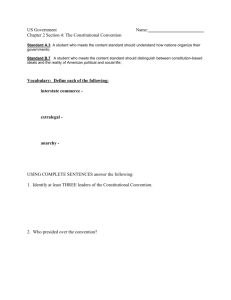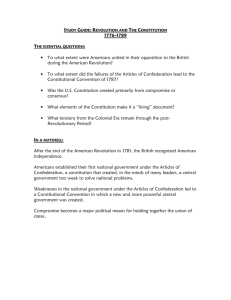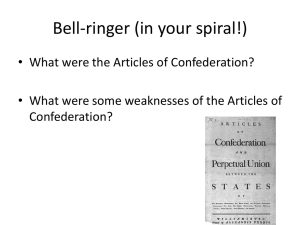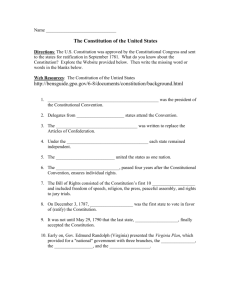The Constitutional Convention
advertisement
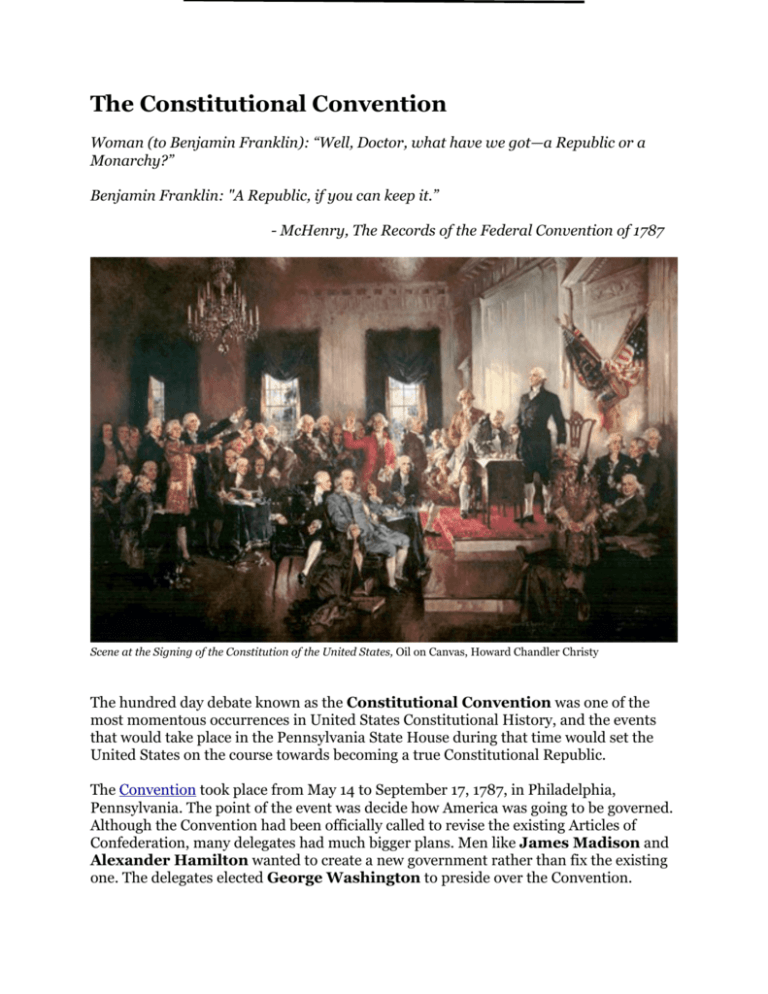
The Constitutional Convention Woman (to Benjamin Franklin): “Well, Doctor, what have we got—a Republic or a Monarchy?” Benjamin Franklin: "A Republic, if you can keep it.” - McHenry, The Records of the Federal Convention of 1787 Scene at the Signing of the Constitution of the United States, Oil on Canvas, Howard Chandler Christy The hundred day debate known as the Constitutional Convention was one of the most momentous occurrences in United States Constitutional History, and the events that would take place in the Pennsylvania State House during that time would set the United States on the course towards becoming a true Constitutional Republic. The Convention took place from May 14 to September 17, 1787, in Philadelphia, Pennsylvania. The point of the event was decide how America was going to be governed. Although the Convention had been officially called to revise the existing Articles of Confederation, many delegates had much bigger plans. Men like James Madison and Alexander Hamilton wanted to create a new government rather than fix the existing one. The delegates elected George Washington to preside over the Convention. 70 Delegates had been appointed by the original states to attend the Constitutional Convention, but only 55 were able to be there. Rhode Island was the only state to not send any delegates at all. As history played out, the result of the Constitutional Convention was the United States Constitution, but it wasn't an easy path. The drafting process was grueling. They wanted the supreme law of the United States to be perfect. The first two months of the Convention saw fierce debate over the 15 points of the "Virginia Plan" which had been proposed by Madison as an upgrade to the Articles of Confederation. Yet, the "Committee of the Whole" couldn't agree on anything. So, on July 24 of that year, the Committee of Detail was enacted to handle the drafting process. The United States (U.S.) Constitution was adopted on September 17, 1787 with 39 signatures before being distributed to the States for ratification. The Committee of Detail The Committee of Detail, headed by John Rutledge (nicknamed Dictator John), was in charge of drafting the Constitution. Other members included Edmund Randolph, Oliver Ellsworth, James Wilson, and Nathaniel Gorham. Other than Gorham, the committee members had all been respected lawyers, and would go on to become leading legal figures in the new government (Randolph would be the first attorney general, while Rutledge, Ellsworth and Wilson would become Supreme Court justices). John Rutledge (September 17, 1739 – July 23, 1800) First Governor of South Carolina Head of the Committee of Detail Second Chief Justice to the U.S. Supreme Court Nicknamed “Dictator John” "By doing good with his money, a man, as it were, stamps the image of God upon it, and makes it pass, current for the merchandise of heaven." Edmund Randolph (August 10, 1753 – September 12, 1813) First United States Attorney General Second Secretary of State "The general object was to produce a cure for the evils under which the United States labored; that in tracing these evils to their origins, every man had found it in the turbulence and follies of democracy." Oliver Ellsworth (April 29, 1745 – November 26, 1807) Senator of Connecticut Third Chief Justice of the United States "The powers of congress must be defined, but their means must be adequate to the purposes of their constitution. It is possible there may be abuses and misapplications; still, it is better to hazard something than to hazard at all." James Wilson September 14,1742 - August 21, 1798 One of Six Original Justices Appointed by George Washington to the U.S. Supreme Court "Government, in my humble opinion, should be formed to secure and to enlarge the exercise of the natural rights of its members; and every government, which has not this in view, as its principal object, is not a government of the legitimate kind." Nathaniel Gorham May 27, 1738 – June 11, 1796 14th President of the United States under the Articles of Confederation Helped draft the Massachusetts Constitution "Any person chosen governor, or lieutenant-governor, counsellor, senator, or representative, and accepting the trust, shall before he proceed to execute the duties of his place or office, take, make and subscribe the following declaration, viz. “I, __________, do declare, that I believe the Christian religion, and have a firm persuasion of its truth." George Washington and the First Draft of the Constitution The United States Constitution was drafted by the Committee of Detail, who used bits and pieces from original Virginia Plan, the decisions of the Convention on modifications to that plan, along with other sources including the Articles of Confederation, to produce the first full draft. From August 6 to September 10, the report of the Committee of Detail was discussed, section-bysection, and clause-by-clause. The most famous copies of this early draft are the ones annotated by President George Washington. This draft of the Constitution displays Washington's handwritten notes in pencil, recording the Convention's handling of each proposed clause. Once this phase of the Convention had ended, on September 10, a Committee of Style was appointed to "polish up the document." William Samuel Johnson headed up the Committee. Other notable figures involved were Alexander Hamilton, Gouverneur Morris, James Madison, and Rufus King. Gouverneur Morris, the delegate from Pennsylvania with a name hard to forget, is credit with writing the Preamble: "We the people of the United States, in order to form a more perfect union, establish justice, insure domestic tranquility, provide for the common defense, promote the general welfare, and secure the blessings of liberty to ourselves and our posterity, do ordain and establish this Constitution for the United States of America." The Lost Draft of James Wilson According to the Historical Society of Pennsylvania, the earliest surviving version of the United States Constitution was written by member of the Committee of Detail, James Wilson. However, for more than 200 years it had been "lost to history," a United States Constitutional legend. In late 2010, the unthinkable happened. Researcher Lorianne Updike Toler discovered the missing copy amongst Wilson's papers in the vault of the Pennsylvania Historical Society. It had never been lost, just misplaced. On September 17, 2012 for one day only, this rare copy of Wilson's four page draft was put on display in Philadelphia in honor of the 225th anniversary of the adoption of the U.S. Constitution. However, because of the Documents' sensitivity to light and temperature, they remain under lock and key in the vault, only to emerge under special occasions. *All Portraits/Paintings courtesy of Wikipedia commons - licensed under Creative Commons Attribution-Share-Alike License 3.0. *All Images of Documents courtesy of the National Archives under the Open Government License.

